Using sex toys can be exciting, empowering, and even healthy — but only if you know the right dos and don’ts. From safe materials to proper cleaning and technique, a few smart choices can turn good play into great play while avoiding common mistakes.
This guide walks you through the essentials of using sex toys safely and confidently, whether you’re new to them or just want to upgrade your routine.
Table of Contents
- Materials & Product Safety Tips
- Using Sex Toys: Cleaning & Storage
- Body & Hygiene Practices When Using Sex Toys
- Sex Toy Use & Techniques
- Contexts & Special Considerations
- Maintenance & Lifespan of Your Adult Toys
- Shopping & Buying Smart
- FAQs About Using Sex Toys Safely
- Embracing Sex Toys as Part of a Healthy Sex Life
Materials & Product Safety Tips
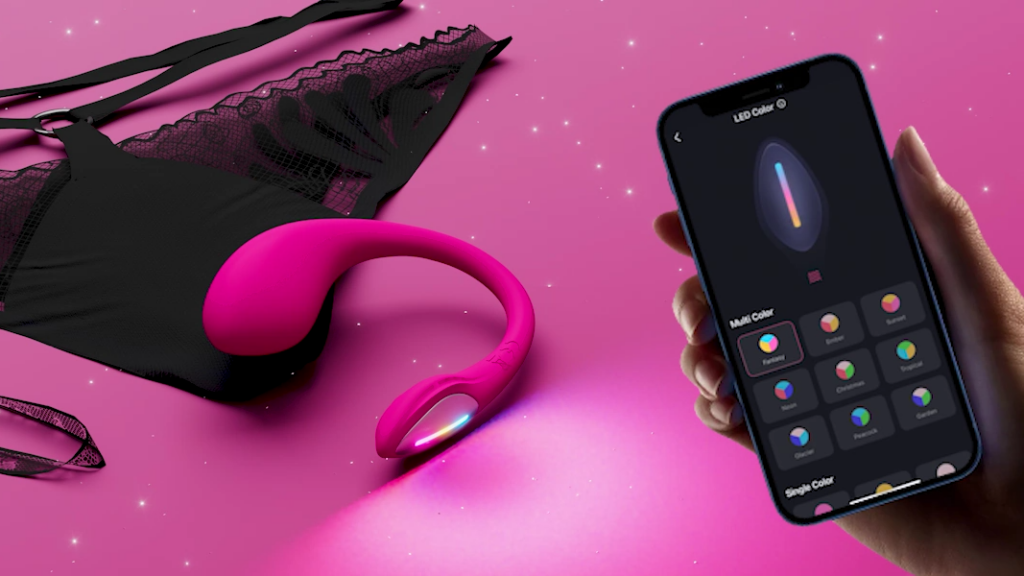
Quick Dos
- Do choose body-safe, non-porous materials.
- Do check for certifications (FDA, CE, RoHS).
- Do inspect for rough seams or smells.
- Do prefer trusted manufacturers.
- Do replace toys showing wear.
Quick Don’ts
- Don’t use porous jelly/rubber toys.
- Don’t ignore chemical odors or sticky surfaces.
- Don’t assume “phthalate-free” means entirely safe.
- Don’t buy knock-offs or novelty junk.
- Don’t use toys without flared bases anally.
Breaking It Down Further
When it comes to sex toy safety, the most important factor is what your toy is made of. Safe sex toy materials (like medical silicone and stainless steel) are always non-porous, meaning they don’t absorb fluids or bacteria.
- Medical-grade silicone, stainless steel, borosilicate glass, and ABS plastic are considered the safest options and are recognized as standard body-safe sex toy materials.
- These materials are smooth, durable, and easy to clean — lowering the risk of irritation or infection.
- Porous toys, like jelly rubber or “mystery blends,” can trap bacteria even after cleaning, making them a serious mistake to avoid.
Toy hygiene standards, like certifications, are another detail worth checking. Labels like FDA-approved, CE-marked, or RoHS-compliant don’t guarantee perfection, but they do mean the toy has passed some testing for harmful chemicals or unsafe design.
Before you use anything new, take a close look at it.
- Rough seams, cracks, or sharp edges are signs of poor manufacturing.
- A strong chemical smell or sticky surface usually means low-quality materials or early breakdown.
Cheap knock-offs and novelty items are easy to find, but they often cut corners on materials and ignore basic adult toy care guide safety. Some are made from recycled plastics mixed with unknown chemicals, and they’re rarely transparent about testing.
👉 Trusted brands and specialty retailers are far safer choices (like Lovense, Lelo, Lovehoney, Kiiroo, Dame, Emojibator, Fleshlight – and so many more) because they disclose full material breakdowns. For example, the Lush 4 app-controlled vibrator by Lovense is made from medical-grade silicone and built for safe, comfortable play.
Even with quality toys, nothing lasts forever.
- Cracks, fading, discoloration, or a change in texture are all signs it’s time to retire a toy.
- Anal toys should always have a flared base to prevent them from slipping too far inside — one of the most common and preventable sex toy accidents.
Using Sex Toys: Cleaning & Storage
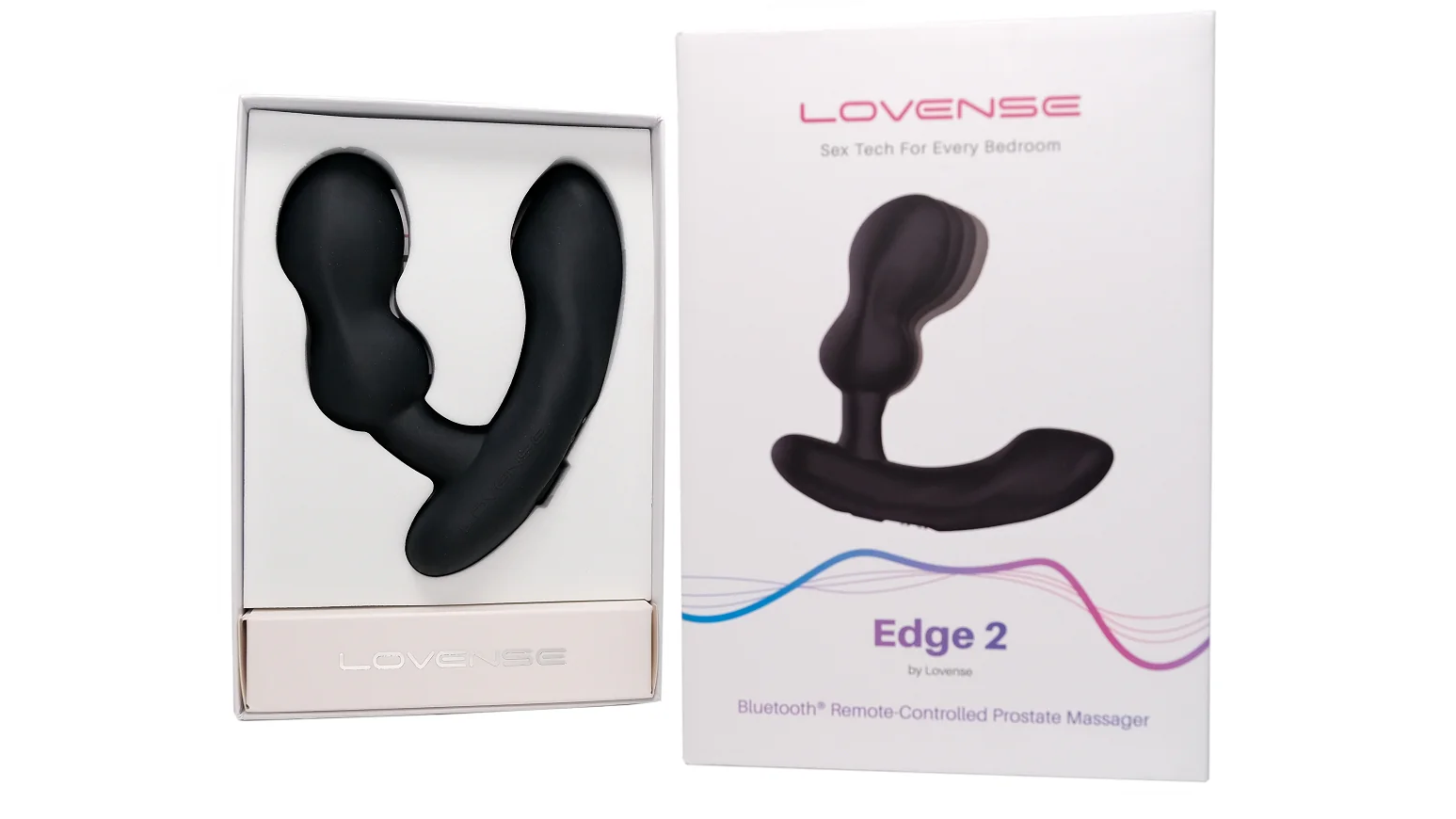
Quick Dos
- Do wash before and after every use.
- Do use appropriate methods (boiling for silicone/glass/steel, wipes for motors).
- Do dry completely before storage.
- Do store in lint-free pouches/cases.
- Do label chargers to avoid mix-ups.
Quick Don’ts
- Don’t submerge motorized toys.
- Don’t leave toys damp.
- Don’t use harsh cleaners or bleach.
- Don’t store silicone toys touching.
- Don’t leave toys in hot or humid spaces.
Expanded Paragraphs
- Different cleaning methods by material.
- Storage hazards (heat, humidity, chemical leeching).
- Long-term toy lifespan with good care.
- Debunk cleaning myths (dishwashers, boiling all toys).
How to Clean and Store Sex Toys Safely
Cleaning is the biggest factor in keeping toys safe and long-lasting. Germs and fluids left on a toy can cause infections or irritation the next time you use it, which is why washing both before and after each session is so important.
- Non-motorized toys (like silicone, glass, or stainless steel) can be boiled to clean silicone sex toys and similar materials because high heat kills bacteria completely
- Motorized or rechargeable toys can’t go in boiling water — that ruins the electronics. Instead, mild soap and warm water are safe, or use toy-specific cleaners that are made to disinfect without corrosion.
- Wipes work for quick cleaning in between uses, but on their own they won’t remove everything. Think of them as a stopgap, not a solution.
Drying properly is just as critical as cleaning. Any leftover water trapped in seams or charging ports creates a perfect home for bacteria and mold. It also speeds up the breakdown of materials, especially silicone. A soft, lint-free cloth helps toys dry fully without leaving fuzz behind.
How to Store Sex Toys
Storage matters more than most people realize. Toys tossed loose into a drawer can pick up dust, lint, or even chemicals from cosmetics. Keeping them in lint-free pouches or individual bags avoids those risks. And specific hazards to avoid include:
- Silicone toys touching each other → the materials can fuse or leech, leaving sticky spots and ruined textures.
- High heat or direct sunlight → batteries can swell, and plastics can warp.
- Humidity (like in a bathroom cabinet) → speeds up mold growth and weakens rubber seals.
Chargers are another hidden issue. Many rechargeable toys use similar-looking cords, but plugging the wrong one in can damage the battery or reduce its lifespan. Label cords, or keep each toy and charger together to avoid mix-ups.
Finally, it’s worth addressing a few myths. Dishwashers might sound like an easy cleaning hack, but detergents and high heat can crack materials or leave behind residues you don’t want inside your body. Boiling is also not a universal fix — it’s perfect to sterilize sex toys made of solid, non-motorized materials, but it will ruin anything with a motor, battery, or decorative coating. Always double-check manufacturer instructions before trying it.
Body & Hygiene Practices When Using Sex Toys
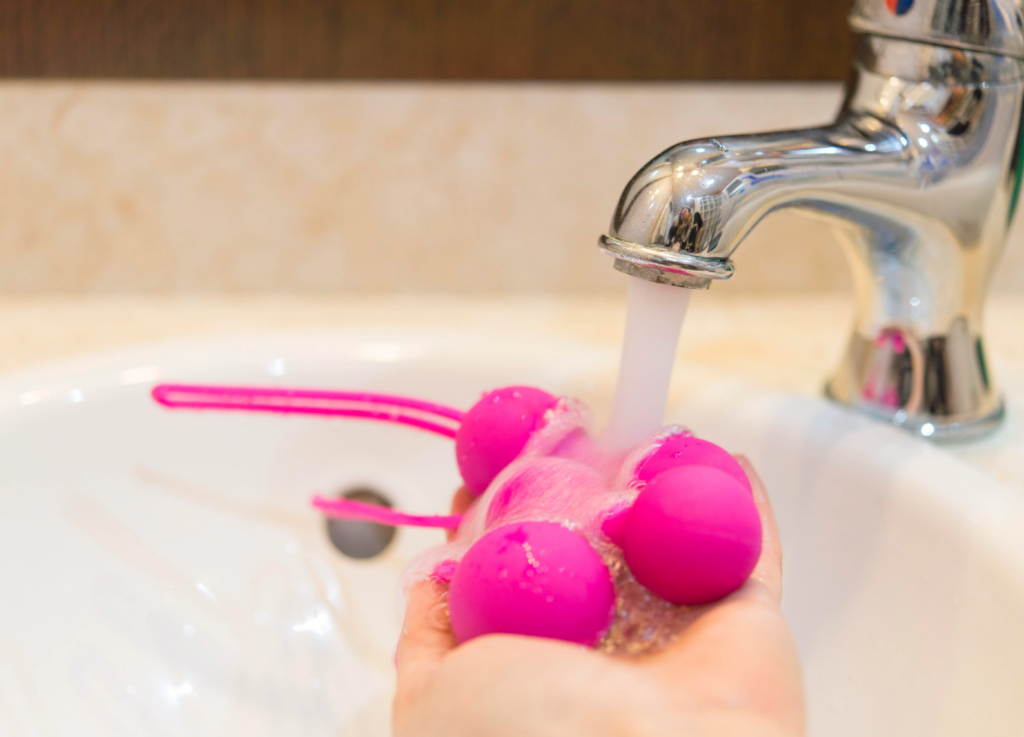
Quick Dos
- Do use condoms or barriers when sharing.
- Do switch barriers between orifices.
- Do use body-safe lubes (unscented, glycerin-free).
- Do check for allergies (nickel, latex).
- Do communicate openly with partners.
Quick Don’ts
- Don’t move toys directly from anal to vaginal use.
- Don’t use silicone lube with silicone toys.
- Don’t share without cleaning or protection.
- Don’t ignore irritation or allergic reaction.
- Don’t assume water-based lube = always safe (some contain glycerin).
Sex Toy Hygiene Tips You Need to Know
Sex toys aren’t just about pleasure — hygiene is a huge part of staying safe and avoiding infections. When toys are shared, bacteria and viruses can easily be passed from one person to another. Using condoms or barriers reduces that risk, especially when switching between partners or orifices. If the same toy is used both anally and vaginally, it needs a fresh barrier or a thorough cleaning in between. Skipping this step can lead to STIs, UTIs, or bacterial infections.
Sex toy compatibility lubricants also matter more than most people realize:
- Water-based lubes are the most versatile, but some contain glycerin, which can increase the risk of yeast infections.
- Silicone lubes last longer, but they break down silicone toys — a costly mistake.
- Oil-based lubes are fine for glass or steel toys but unsafe with latex condoms.
Allergies are another factor that often gets overlooked. Some toys contain nickel in coatings or alloys, while others might have trace latex. Both can cause irritation or allergic reactions. If you notice redness, itching, or unusual discomfort, stop using the toy immediately and switch to hypoallergenic materials.
Finally, communication is hygiene too. Being open with partners about how toys are cleaned, what lubes are used, and how they’ll be shared prevents misunderstandings and health risks. Talking through it sets a baseline of trust so everyone knows the play is safe as well as fun.
Sex Toy Use & Techniques

Quick Dos
- Do start small and slow.
- Do warm up with foreplay.
- Do experiment with angles/positions.
- Do test vibration intensities gradually.
- Do stop immediately if in pain.
Quick Don’ts
- Don’t force insertion.
- Don’t skip lube.
- Don’t repurpose household items.
- Don’t use toys that are too advanced as a beginner.
- Don’t ignore your body’s feedback.
How to Use Sex Toys Safely and Comfortably
The way you approach toy use makes all the difference between a fun experience and a painful mistake. Starting small and slow is especially important for beginners. Jumping straight into larger or more intense toys can cause microtears, discomfort, or even long-term sensitivity issues. Warm-up matters too — a few minutes of foreplay or solo stimulation helps muscles relax, makes insertion easier, and reduces the risk of pain.
Experimenting with angles and positions lets you find what feels good for your body. Some toys work best when angled toward the front wall (for G-spot stimulation), others when angled downward or side to side.
If you’re curious about dual stimulation, things like rabbit vibrators [see Lovense Nora for reference] or adjustable prostate massagers with paranium stimulation.
🛑 There’s no single “correct” way, so play around until you discover what feels best.
- Smaller toys = safer for beginners, easier for learning.
- Foreplay = essential prep for comfort and arousal.
- Angles matter — tiny shifts can change the sensation entirely.
Vibration should always start at the lowest intensity. Many people find higher settings numbing or even painful if used too soon. Gradually increase power only if it feels good, and switch settings if one gets too overwhelming. Stopping the moment you feel pain or discomfort is not a failure — it’s how you keep your body safe.
Safe Anal Toy Techniques
Anal toy safety for beginners requires its own set of rules. The anus doesn’t self-lubricate, so lube is non-negotiable. Generous amounts of water- or oil-based lube make insertion smoother and prevent tearing. Relaxation is equally critical — rushing anal play often causes pain and makes muscles tighten up.
- Always choose toys with a flared base so they don’t slip too far inside.
- Begin with slim plugs or beads before moving to larger toys.
- Take breaks and reapply lube as needed.
Skipping these basics is one of the most common causes of injuries — avoid injury sex toy use mistakes at all costs. Done carefully, though, anal play can be safe and deeply pleasurable.
👉 For anal play, choosing toys that are easy to clean and safe to retrieve matters. Lovense Hush 2 vibrating butt plug is a good example — it’s fully body-safe, rechargeable, and made with a flared base for safety.
Partner Play and Shared Exploration
Using toys with a partner brings another layer of communication and trust. Some people worry about toys “replacing” intimacy, but in reality, they often enhance it. Talk openly about what feels good, what doesn’t, and how you want to incorporate toys into your sex life.
Foreplay with toys can be a way to build anticipation, while adding vibration during penetration can increase sensation for both partners. The key is to see toys as tools for exploration, not as a performance test.
- Use toys to add variety, not pressure.
- Check in with your partner often about comfort and pleasure.
- Be willing to experiment together — mutual discovery strengthens intimacy.
Contexts & Special Considerations

Quick Dos
- Do consult a doctor if pregnant or healing postpartum.
- Do choose ergonomic toys if living with disability/pain.
- Do adjust technique for medical conditions.
- Do prioritize communication with partners in special contexts.
- Do double-check cleanliness if immune-compromised.
Quick Don’ts
- Don’t assume all toys are pregnancy safe.
- Don’t use toys on open wounds/infections.
- Don’t skip medical clearance postpartum.
- Don’t use unsafe chargers or old motors.
- Don’t ignore chronic pain signals.
Special Safety Guidelines for Pregnancy, Recovery, and Health Conditions
Not every situation calls for the same approach to sex toy use. Sometimes your body needs extra care, and the rules shift.
Pregnancy is one of those times. Many toys are safe, but not all of them. Vibrations are generally fine, but anything that involves deep penetration or strong suction may cause discomfort or complications. The safest move is to check with a doctor before introducing new toys.
Postpartum recovery is another stage where caution matters. After birth, tissues are healing, and even small tears need time to close. Using toys too soon can increase the risk of infection or reopen wounds. A healthcare provider’s clearance is the best green light before resuming toy use.
For people living with disabilities or chronic pain, ergonomic designs can make a big difference. Toys with handles, remote controls, or flexible shafts reduce strain and make play accessible without pushing the body past its limits. Pain signals should always be respected — pushing through discomfort can turn a playful moment into an injury.
- Ergonomic grips and adaptive designs = less strain on joints and muscles.
- Remote-controlled or wearable toys = easier for partners to assist.
Hygiene also deserves extra attention if you’re immune-compromised or recovering from surgery. Bacteria that a healthy body might fight off can be more dangerous in these cases, so double-cleaning and using condoms or barriers is strongly recommended. Avoid using toys on or near open wounds, stitches, or healing scars.
Finally, communication becomes even more important in these contexts. Being upfront with partners about what feels safe and what doesn’t helps prevent pressure, pain, or accidental harm. Special circumstances don’t mean toys are off the table — they just mean extra care goes into how they’re chosen and used.
Maintenance & Lifespan of Your Adult Toys
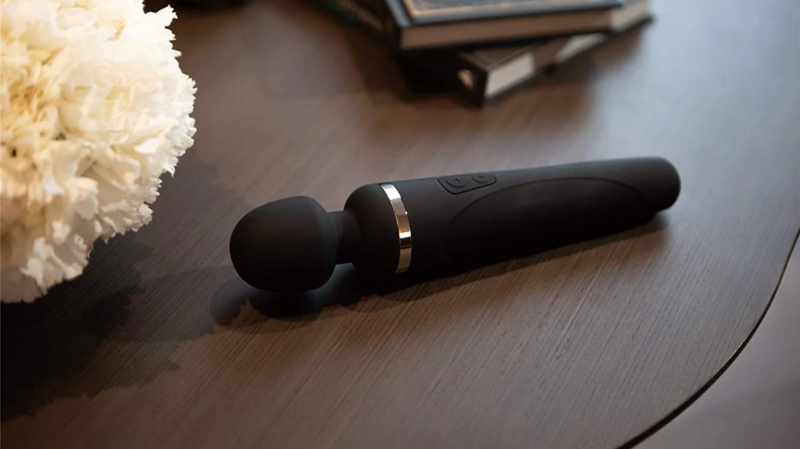
Quick Dos
- Do inspect toys regularly.
- Do follow charging instructions.
- Do note manufacturer warranties.
- Do replace fraying cords.
- Do retire toys at the first sign of damage.
Quick Don’ts
- Don’t keep using cracked/glued toys.
- Don’t ignore heat or swelling batteries.
- Don’t assume toys last forever.
- Don’t store uncharged long-term (for lithium batteries).
- Don’t assume warranty = safety approval.
How to Make Sex Toys Last Longer (and Know When to Retire Them)
Every sex toy has a lifespan, even when it’s made from high-quality materials. Silicone, glass, and stainless steel can last years if cared for properly, while porous plastics or cheaper blends wear out much faster. Motors, batteries, and moving parts also add limits — they’ll degrade over time no matter what.
Regular inspection is the easiest way to stay safe.
- Cracks or glued seams can trap bacteria and cause injuries.
- Fading, discoloration, or sticky surfaces are signs of material breakdown.
- Fraying cords or loose charging ports should never be ignored — they’re fire hazards as well as functional issues.
Charging habits make a big difference, especially with lithium batteries. Overcharging or leaving toys uncharged for months at a time shortens battery life. Following the manufacturer’s instructions — even if it feels fussy — can keep a toy usable for years longer.
Warranties can offer peace of mind, but they don’t automatically mean a toy is well-made. Always combine warranty info with your own checks. If something feels off — heat, swelling, or strange noises — retire the toy immediately rather than trying to fix it with glue or tape. The risks to your body aren’t worth the savings
Shopping & Buying Smart
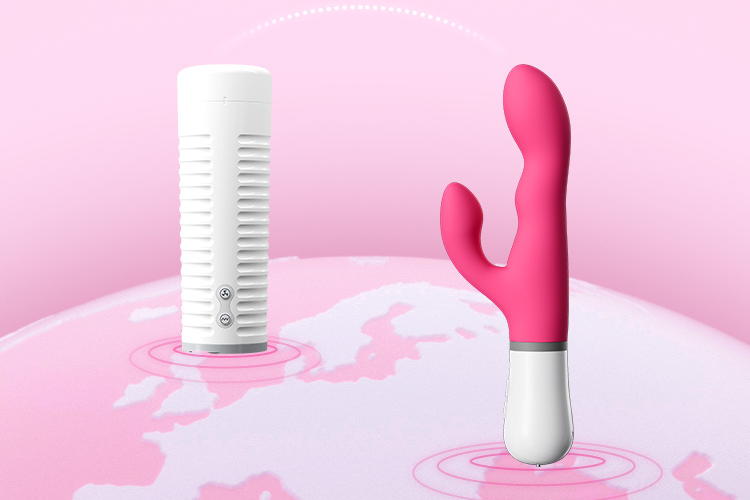
Quick Dos
- Do buy from trusted brands or retailers.
- Do read independent reviews.
- Do compare warranty/return policies.
- Do choose beginner kits if new.
- Do prioritize discreet shipping if needed.
Quick Don’ts
- Don’t buy toys from unverified marketplaces (eBay, Wish, AliExpress).
- Don’t rely only on product star ratings.
- Don’t ignore sizing specs.
- Don’t assume “expensive” = safe.
- Don’t skip checking noise level/battery life if discreetness matters.
How to Choose Safe and Reliable Sex Toys
Where you shop is just as important as what you buy. Trusted brands and specialty retailers are safer bets because they disclose materials and meet standards. Counterfeits from unverified marketplaces often use unsafe plastics, weak motors, or misleading labels.
Independent reviews tell you more than star ratings alone. Look for comments on durability, noise, and comfort — things product pages often gloss over.
Price doesn’t equal safety. A toy that’s too large or advanced can cause injury, even if it’s expensive. Beginners usually do best with smaller, simpler designs or starter kits.
Other details to check:
- Counterfeits: avoid sellers without clear safety marks, real product photos, or return policies.
- Warranties: 6–12 months is standard, but always read the fine print.
- Discreet shipping: most reputable shops include it, but confirm if privacy matters.
FAQs About Using Sex Toys Safely
How can I use sex toys safely without injury?
Start slow, use plenty of lube, and never force insertion. Pay attention to your body’s feedback — if it hurts, stop immediately.
What is the best lubricant to use with sex toys?
Water-based lube is the most versatile and safe with all toy materials. Silicone lube lasts longer but will damage silicone toys. Oil-based lube should only be used with glass or steel toys.
How do I clean and sterilize silicone sex toys?
Wash with warm water and unscented soap after every use. For non-motorized silicone, boil for 3–5 minutes to sterilize. Dry completely before storing.
Is it okay to share sex toys with a partner?
Yes — but always use a condom or barrier, and switch to a new one if moving between orifices. Proper cleaning between partners is essential.
Are there materials I should avoid in sex toys?
Yes. Avoid porous materials like jelly rubber or blends labeled as “novelty use only.” Stick to medical-grade silicone, glass, stainless steel, or ABS plastic.
How often should I replace or retire a sex toy?
At the first signs of cracks, discoloration, battery swelling, or sticky texture. Even with care, most toys last 1–5 years depending on material and motor quality.
Can I use sex toys during pregnancy or while pregnant?
Yes, but avoid deep penetration and suction toys. Always consult your doctor if you’re uncertain, especially postpartum.
What mistakes do beginners make when using sex toys?
Skipping lube, starting with toys that are too advanced, forcing insertion, and ignoring cleaning are the most common mistakes.
How can couples incorporate sex toys into foreplay?
Use toys to build arousal rather than replace intimacy — vibrators during kissing, toys for teasing erogenous zones, or remote toys for partner control.
How do I store sex toys to keep them safe and clean?
Keep them in lint-free pouches, away from heat and humidity, and don’t let silicone toys touch each other to prevent material damage.
Embracing Sex Toys as Part of a Healthy Sex Life
Sex toys aren’t just accessories — they’re tools for self-discovery and connection. Used safely, they boost confidence, deepen intimacy, and make pleasure more accessible.
The basics matter: choose body-safe materials, clean them well, and listen to your body. From there, toys open the door to curiosity, exploration, and shared enjoyment with partners. Sex positivity means dropping shame and embracing pleasure as part of wellness. With care and respect, toys can be a lasting, healthy part of your sexual life.
❓Not sure where to start? Lovense runs starter-friendly deals that make trying safe toys easier. [Learn more and get deals HERE🔗]



